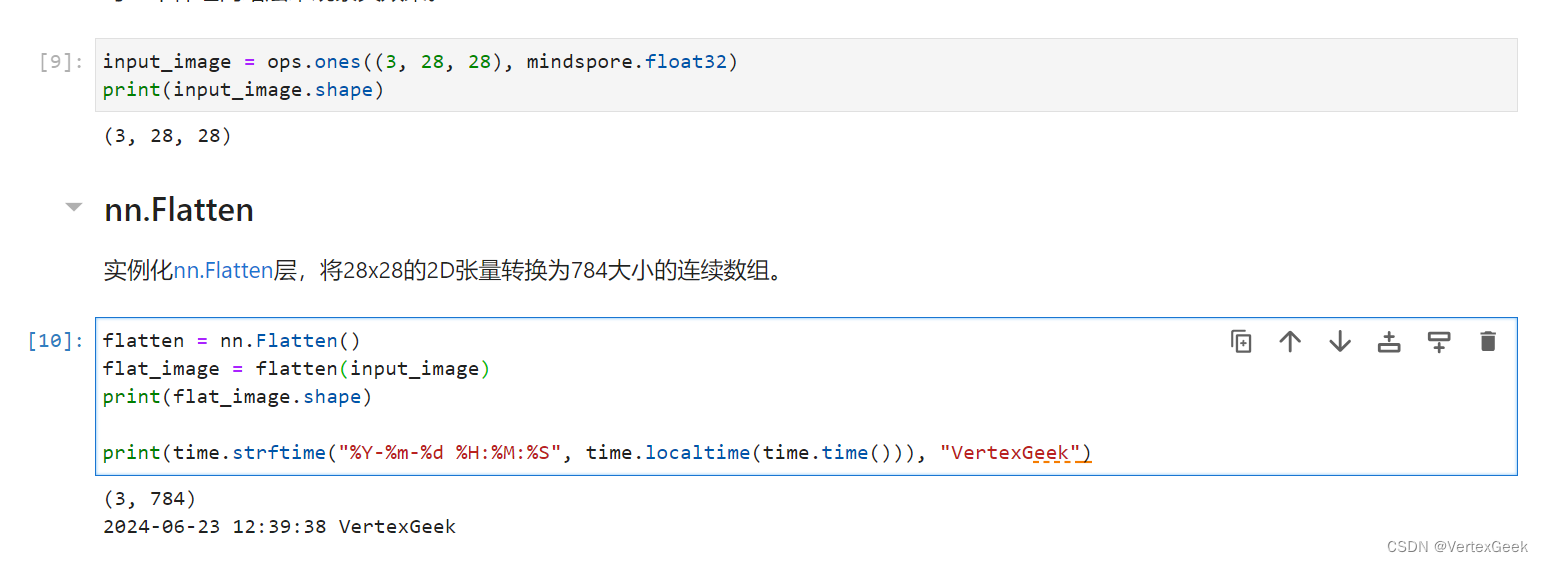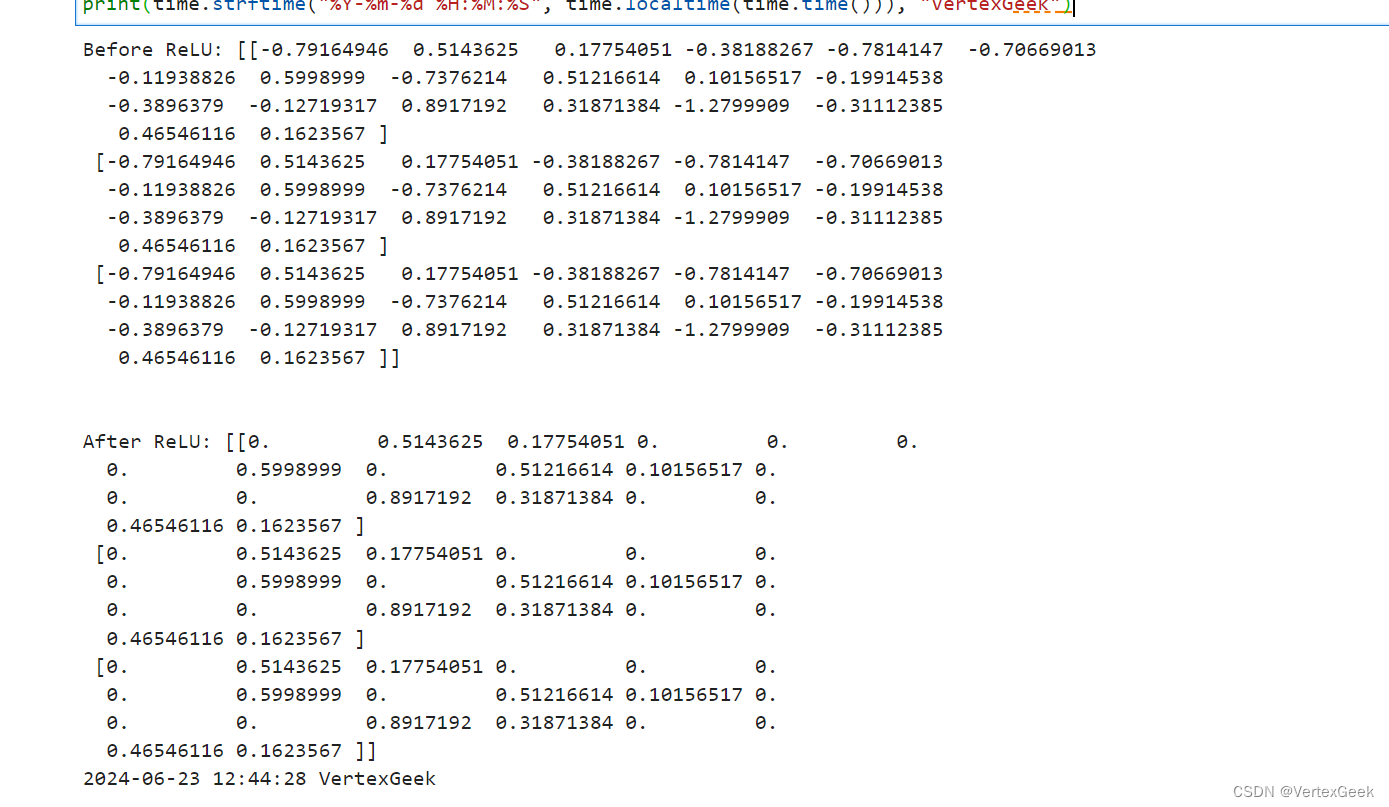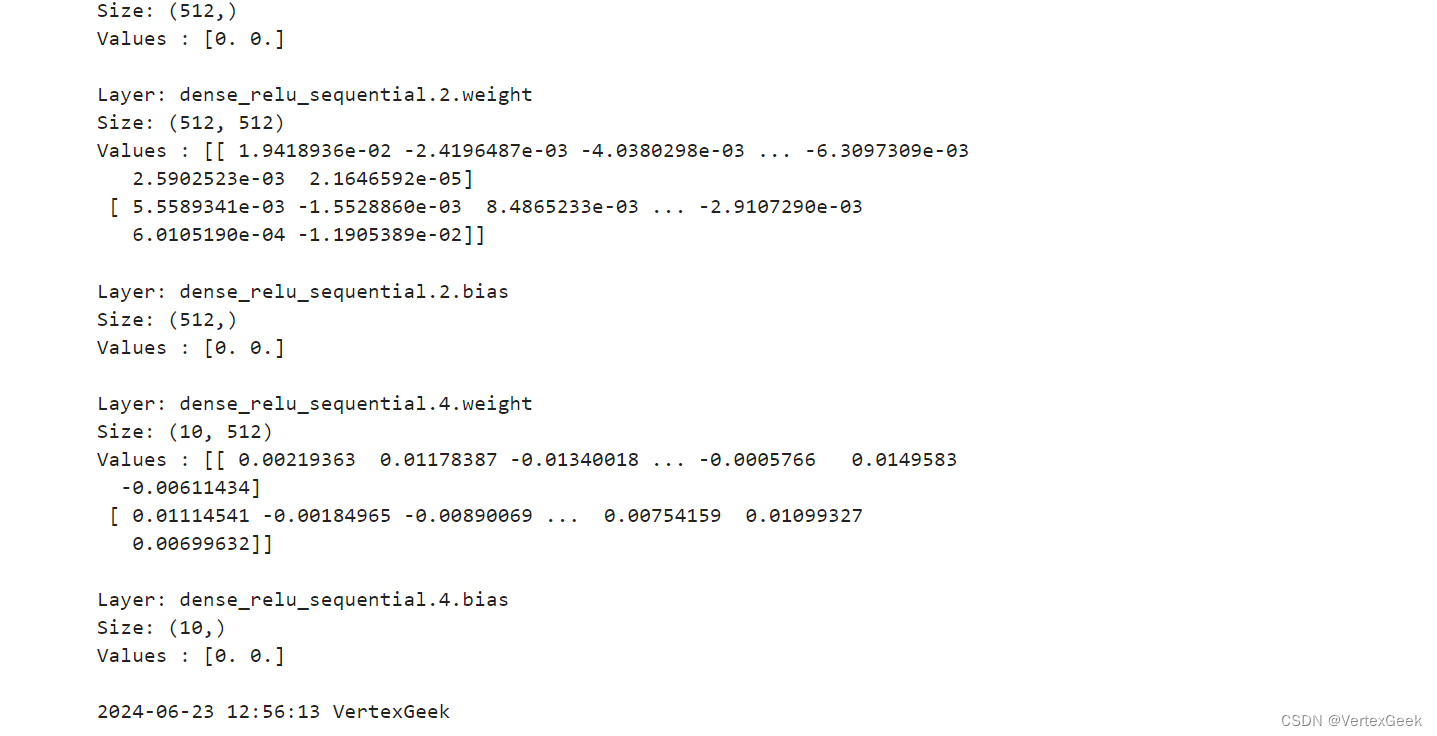昇思25天学习打卡营第5天|网络构建

一、简介:
神经网络模型是由神经网络层和Tensor操作构成的,mindspore.nn提供了常见神经网络层的实现,在MindSpore中,Cell类是构建所有网络的基类(这个类和pytorch中的modul类是一样的作用),也是网络的基本单元。一个神经网络模型表示为一个Cell,它由不同的子Cell构成。使用这样的嵌套结构,可以简单地使用面向对象编程的思维,对神经网络结构进行构建和管理。
二、环境准备:
import mindspore
import time
from mindspore import nn, ops没有下载mindspore的宝子,还是回看我的昇思25天学习打卡营第1天|快速入门-CSDN博客,先下载好再进行下面的操作。
三、神经网络搭建:
1、定义模型类:
我们首先要继承nn.Cell类,并再__init__方法中进行子Cell的实例化和管理,并再construct方法(和pytorch中的forward方法一致)中实现前向计算:
class Network(nn.Cell):def __init__(self):super().__init__()self.flatten = nn.Flatten()self.dense_relu_sequential = nn.SequentialCell(nn.Dense(28*28, 512, weight_init="normal", bias_init="zeros"),nn.ReLU(),nn.Dense(512, 512, weight_init="normal", bias_init="zeros"),nn.ReLU(),nn.Dense(512, 10, weight_init="normal", bias_init="zeros"))def construct(self, x):x = self.flatten(x)logits = self.dense_relu_sequential(x)return logits# 实例化并打印
model = Network()
print(model)
print(time.strftime("%Y-%m-%d %H:%M:%S", time.localtime(time.time())), "VertexGeek") ①self.flatten = nn.Flatten():创建一个Flatten层,并将其作为类的属性。Flatten层的作用是将输入的数据“压平”,即不管输入数据的原始形状如何,输出都将是沿着特定维度的连续数组。
② self.dense_relu_sequential = nn.SequentialCell(...):创建一个SequentialCell,它是一种特殊的Cell,可以顺序地执行其中包含的多个层。这个SequentialCell包含了三个全连接层(Dense),每个全连接层后面跟着一个ReLU激活函数层,除了最后一个全连接层:
-
第一个
nn.Dense(28*28, 512, weight_init="normal", bias_init="zeros"):这是一个全连接层,它接受28*28=784个输入,并产生512个输出。权重(weight_init)和偏置(bias_init)分别使用正态分布和零值进行初始化。 -
nn.ReLU():ReLU激活函数,其数学表达式为f(x) = max(0, x),即负值输出为零,正值保持不变。 -
接下来的两个
nn.Dense与对应的nn.ReLU层与第一个类似,它们分别接收512个输入并再次输出512个值,以及最终输出10个值,这可能对应于10个类别。

我们构造一个数据,并使用softmax预测其概率:
X = ops.ones((1, 28, 28), mindspore.float32)
logits = model(X)
# print logits
print(logits)pred_probab = nn.Softmax(axis=1)(logits)
y_pred = pred_probab.argmax(1)
print(f"Predicted class: {y_pred}")
print(time.strftime("%Y-%m-%d %H:%M:%S", time.localtime(time.time())), "VertexGeek")
2、模型层详解:
(1)nn.Flatten:
nn.Flantten方法用于将输入数据“压平”,以便后续处理:
input_image = ops.ones((3, 28, 28), mindspore.float32)
print(input_image.shape)flatten = nn.Flatten()
flat_image = flatten(input_image)
print(flat_image.shape)print(time.strftime("%Y-%m-%d %H:%M:%S", time.localtime(time.time())), "VertexGeek")
(2)nn.Dense:
nn.Dense层作为全连接层,用于对输入的数据进行线性变换和处理:
layer1 = nn.Dense(in_channels=28*28, out_channels=20)
hidden1 = layer1(flat_image)
print(hidden1.shape)print(time.strftime("%Y-%m-%d %H:%M:%S", time.localtime(time.time())), "VertexGeek")
(3)nn.Relu:
nn.Relu是本次实验中使用的激活函数,用于对神经网络的权重进行处理,以缓解欠拟合和过拟合的发生,常见的激活函数处了Relu,还有:Sigmoid, Tanh等:
print(f"Before ReLU: {hidden1}\n\n")
hidden1 = nn.ReLU()(hidden1)
print(f"After ReLU: {hidden1}")print(time.strftime("%Y-%m-%d %H:%M:%S", time.localtime(time.time())), "VertexGeek")
(4)nn.SequentialCell:
nn.SequentialCell和pytorch中的nn.Sequential的作用一样,用于存放dense全连接层和激活函数层的组合,以方便在前向计算中使用:
seq_modules = nn.SequentialCell(flatten,layer1,nn.ReLU(),nn.Dense(20, 10)
)logits = seq_modules(input_image)
print(logits.shape)print(time.strftime("%Y-%m-%d %H:%M:%S", time.localtime(time.time())), "VertexGeek")
(5)nn.Softmax:
nn.softmax方法将神经网络最后一个全连接层返回的logits的值缩放为[0, 1],表示每个类别的预测概率。axis指定的维度数值和为1。
softmax = nn.Softmax(axis=1)
pred_probab = softmax(logits)
print(pred_probab)
# argmax函数返回指定维度上最大值的索引
y_pred = pred_probab.argmax(1)
print(f"Predicted class: {y_pred}")
print(time.strftime("%Y-%m-%d %H:%M:%S", time.localtime(time.time())), "VertexGeek")
3、模型参数:
网络内部神经网络层具有权重参数和偏置参数(如nn.Dense),这些参数会在训练过程中不断进行优化,可通过 model.parameters_and_names() 来获取参数名及对应的参数详情。
print(f"Model structure: {model}\n\n")for name, param in model.parameters_and_names():print(f"Layer: {name}\nSize: {param.shape}\nValues : {param[:2]} \n")print(time.strftime("%Y-%m-%d %H:%M:%S", time.localtime(time.time())), "VertexGeek")
